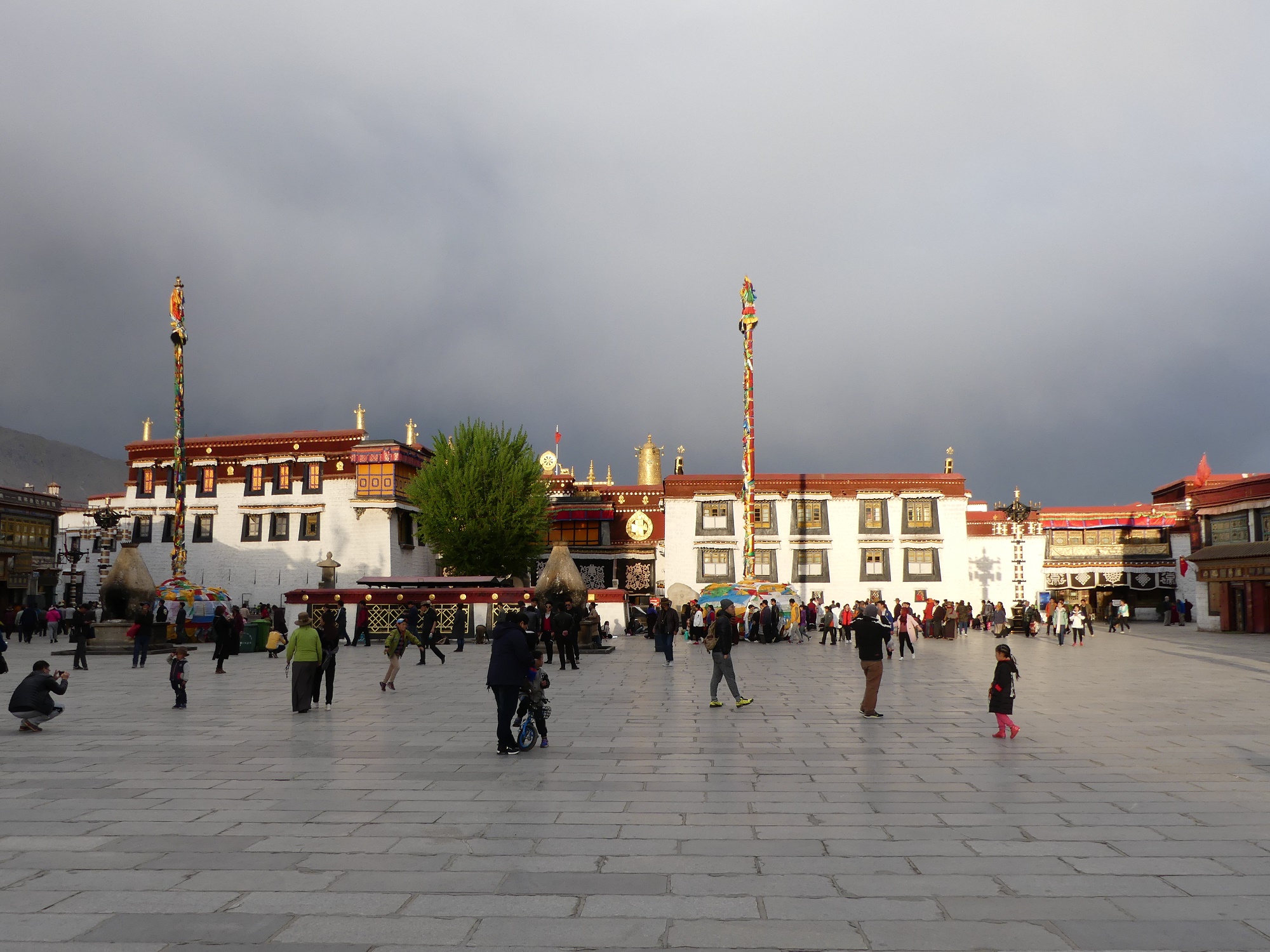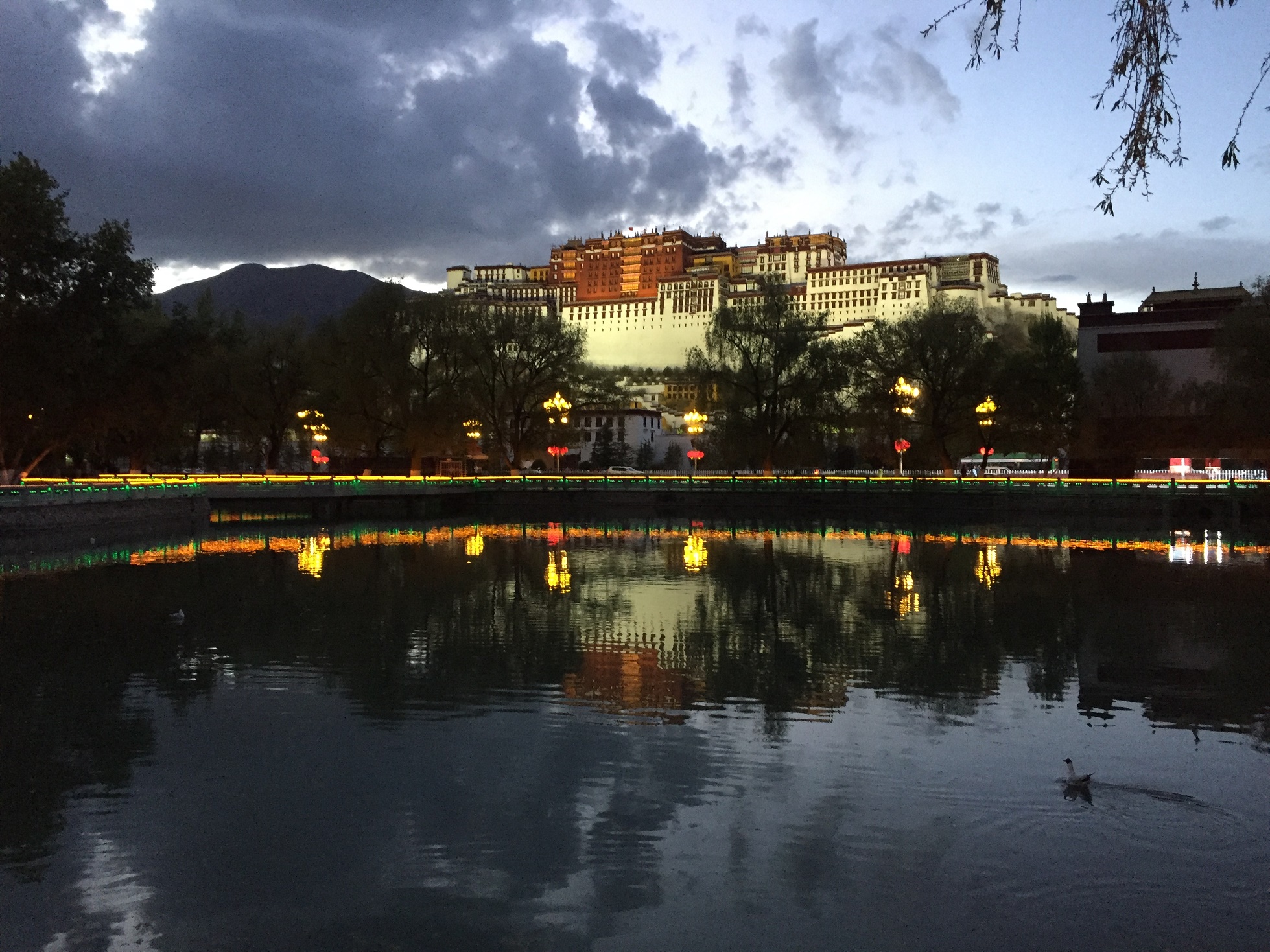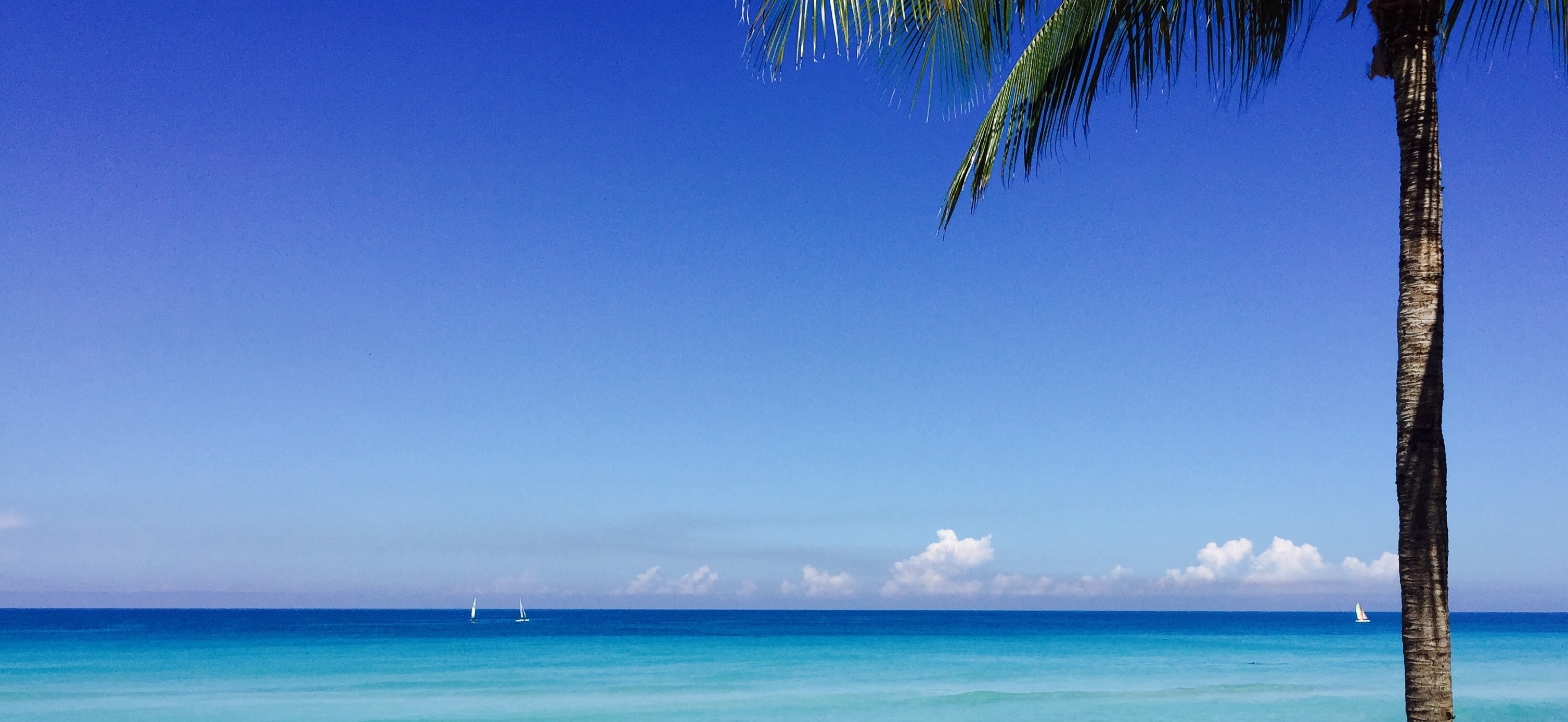Even though we were technically on our way to the west of China, in our minds we were leaving the country and could not be happier. Destination: Lhasa, Tibet.
I have been wanting to come to Tibet for longer than I care to remember and have attempted to enter twice before but, for whatever reason, I was turned back at the border. My most recent attempt was in March 2008. While I had everything booked, big protests on the streets of Lhasa caused a crackdown by the authorities and they cancelled all the permits for the rest of 2008. Since then they have been very strict, limiting the number of foreigners who can visit. While frustrating for us, it is even worse for the local Tibetan people. Their every movement is monitored. Most of their businesses have been appropriated and are now run by Chinese. They cannot apply for passports and their movements are restricted.
We flew over some of the most beautiful mountain landscape with snow-capped mountains on both sides. When we landed I had to check my map app to make sure we were really in Lhasa. I just could not believe it. While on Tibetan soil, I was still expecting an official to examine our visa and refuse us entry, but we passed unscathed. This was the culmination of a lifelong dream. I was in Tibet!
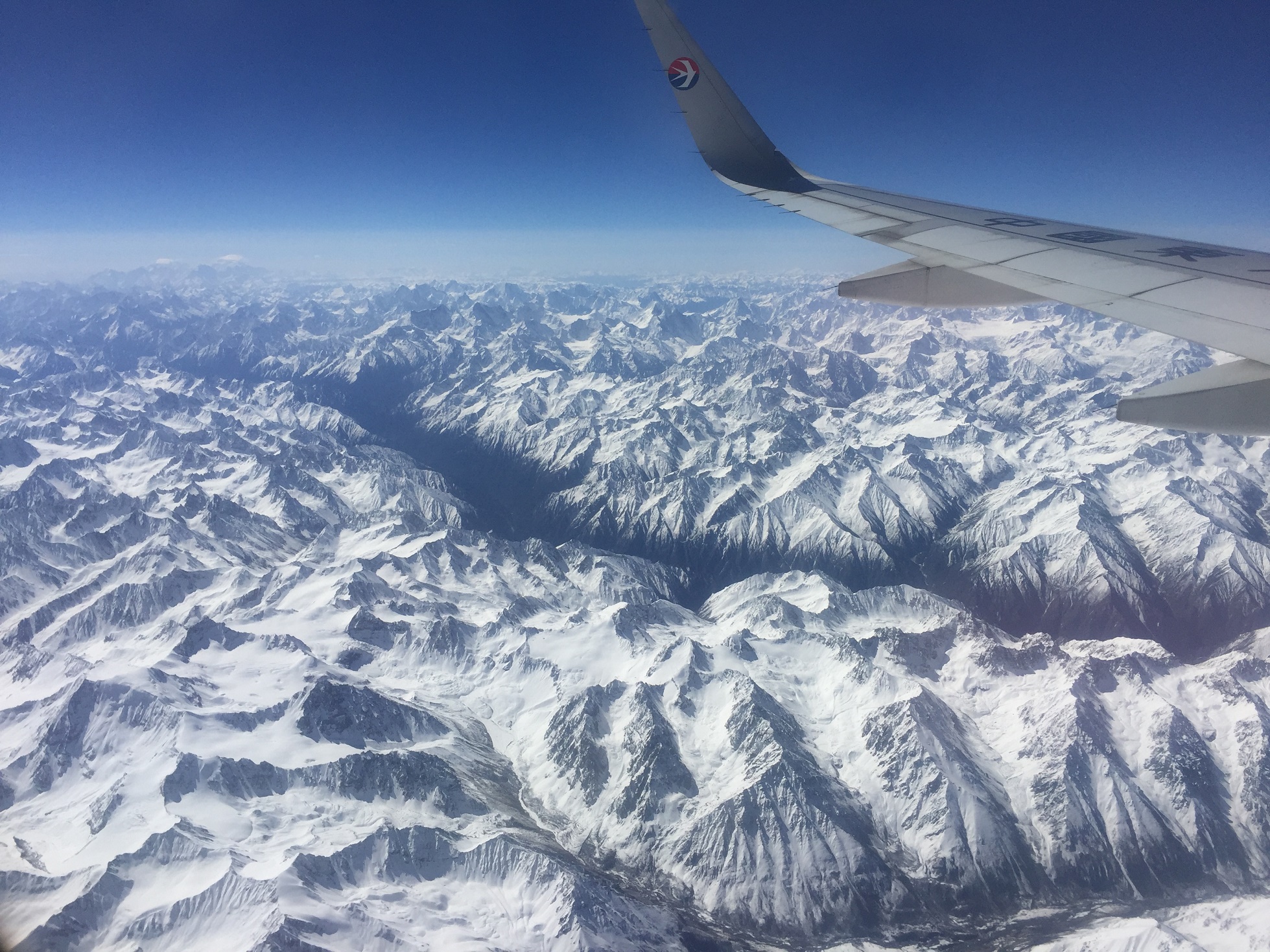
The view from our window looked almost unreal
Our guide for the next week, Gyaltsen, met us at the airport and presented us with a white Tibetan silk scarf signifying good wishes. Gyaltsen had studied in India and his English was near perfect. What a wonderful surprise after two weeks in China and Japan where we were barely understood.
We had the afternoon to ourselves so wasted no time exploring. Our first introduction to the city was quite unique. The old part of Lhasa, where our hotel was located, is still very much Tibetan. As we came to Barkhor Street, we were met with a throng of devoted pilgrims walking the circuit around Jokhang Temple. This is the most holy temple in Tibetan Buddhism and the street is therefore considered a “saint road” in the eyes of Tibetans.
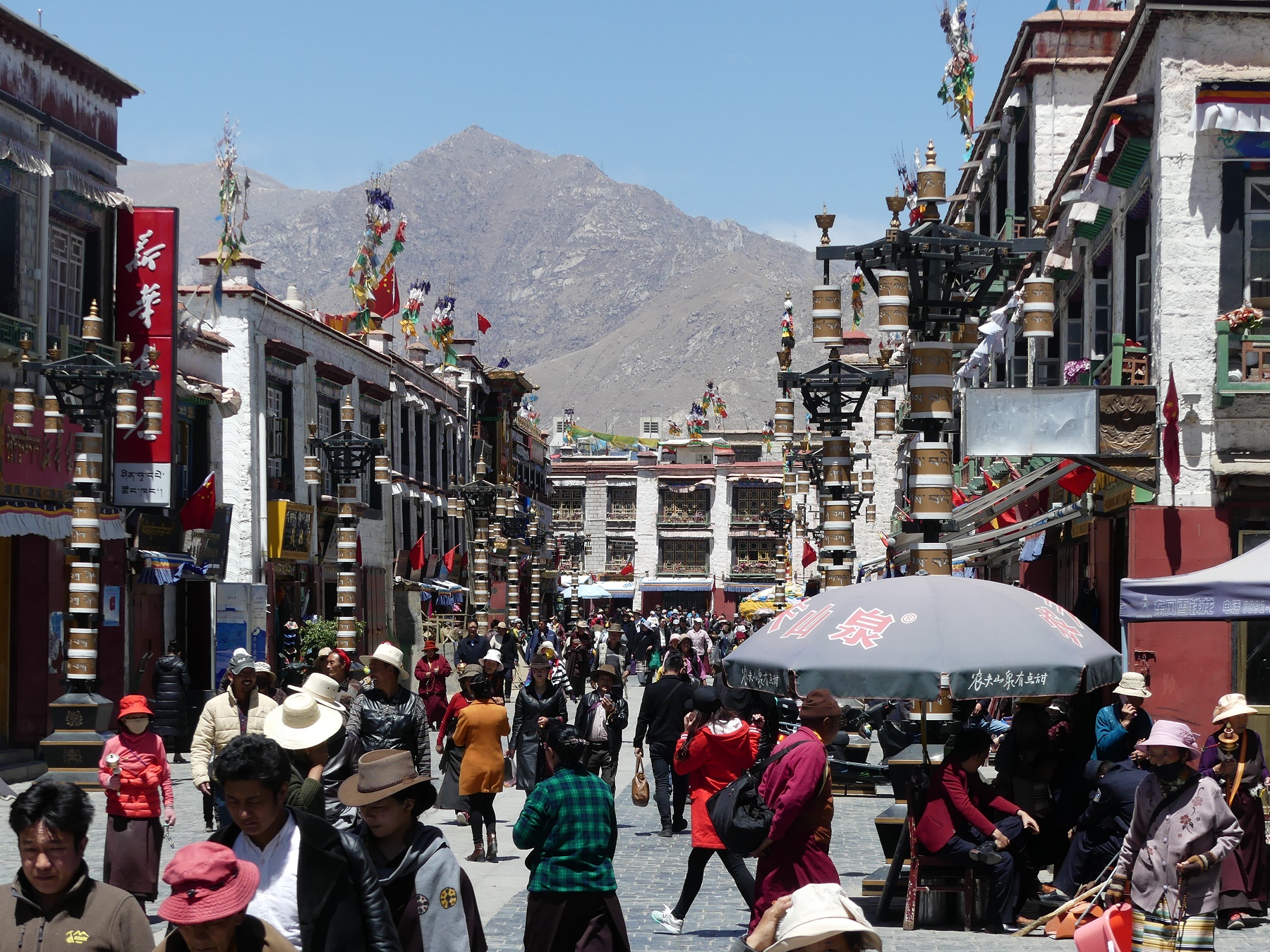
Pilgrims from all over the world come here to walk the saint road (clockwise, always clockwise), pray and say their mantras. Young, old, businessmen, teenagers; the people walk all day and into the night. Some take only a few steps before prostrating themselves and touching their foreheads to the ground – a process that is repeated for hours on end. We fell in with the throng and gracefully lapped the temple ourselves.
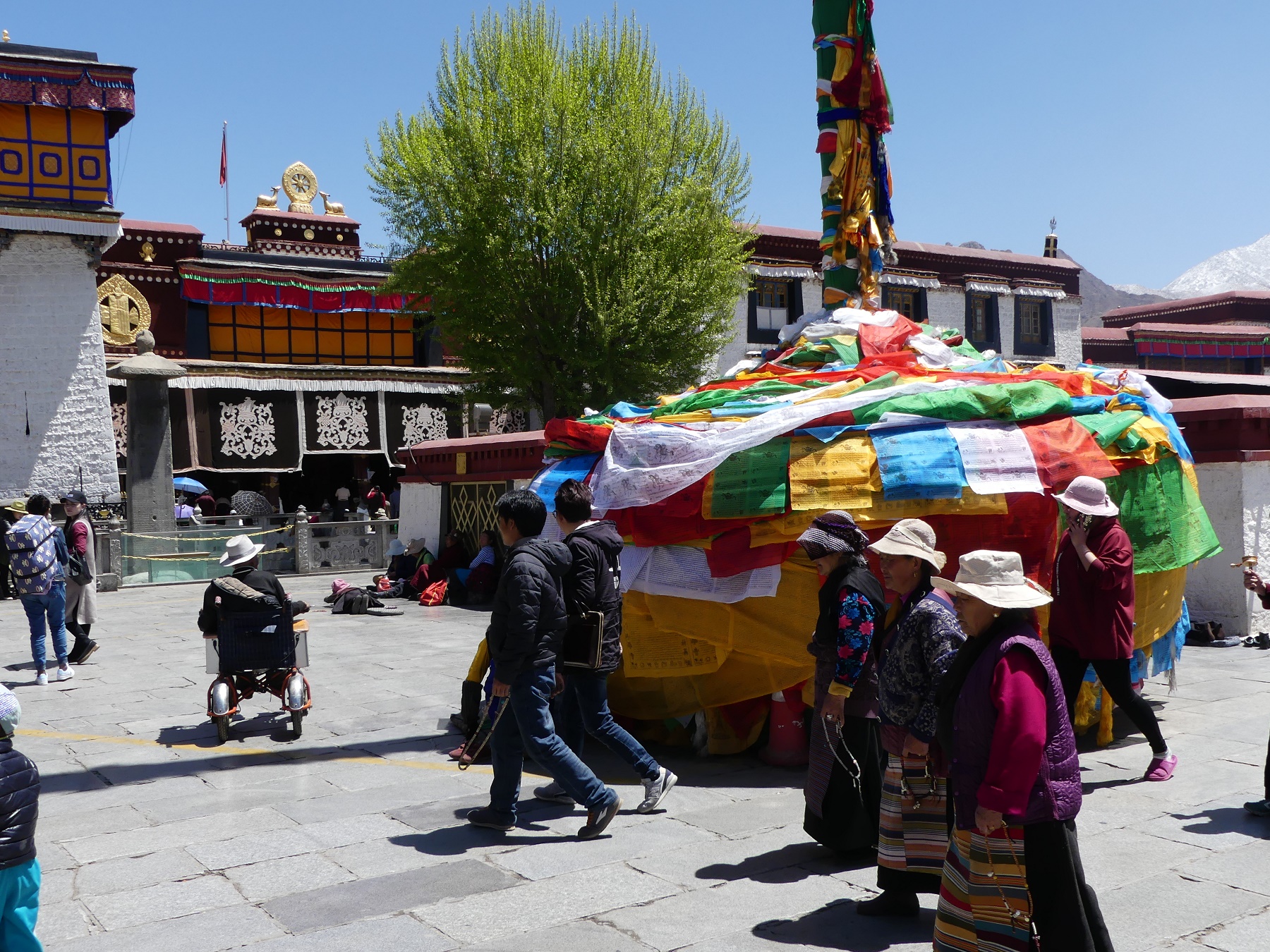
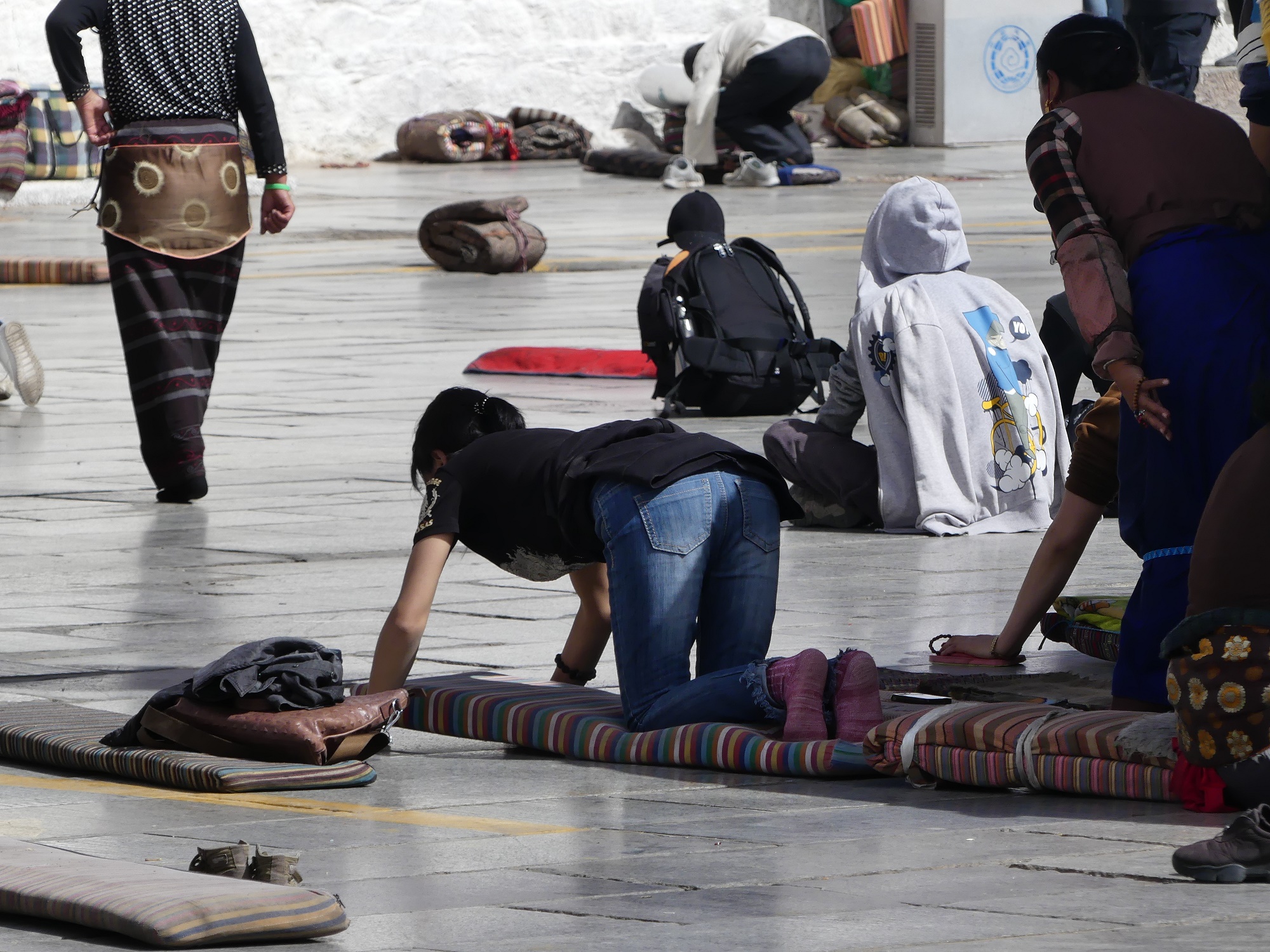
The security around Lhasa, and especially the old town, is particularly tight. There is a police checkpoint with scanners on every corner of the square, with even more police stations dotted in-between. Tibetans have to scan their ID cards every time they enter the square and their movements are constantly monitored by hundreds of surveillance cameras on every lamp post, on every rooftop and inside every shop. Congregations of people around the temples or palace are strictly prohibited. It was very clear that China is trying to control Tibet in a strong and visible way.
We walked through a few more checkpoints to the Potala Palace, Lhasa’s cardinal landmark and one of the great wonders of world architecture. The first sight of the Potala Palace is simply breath-taking and you cannot take your eyes off it.
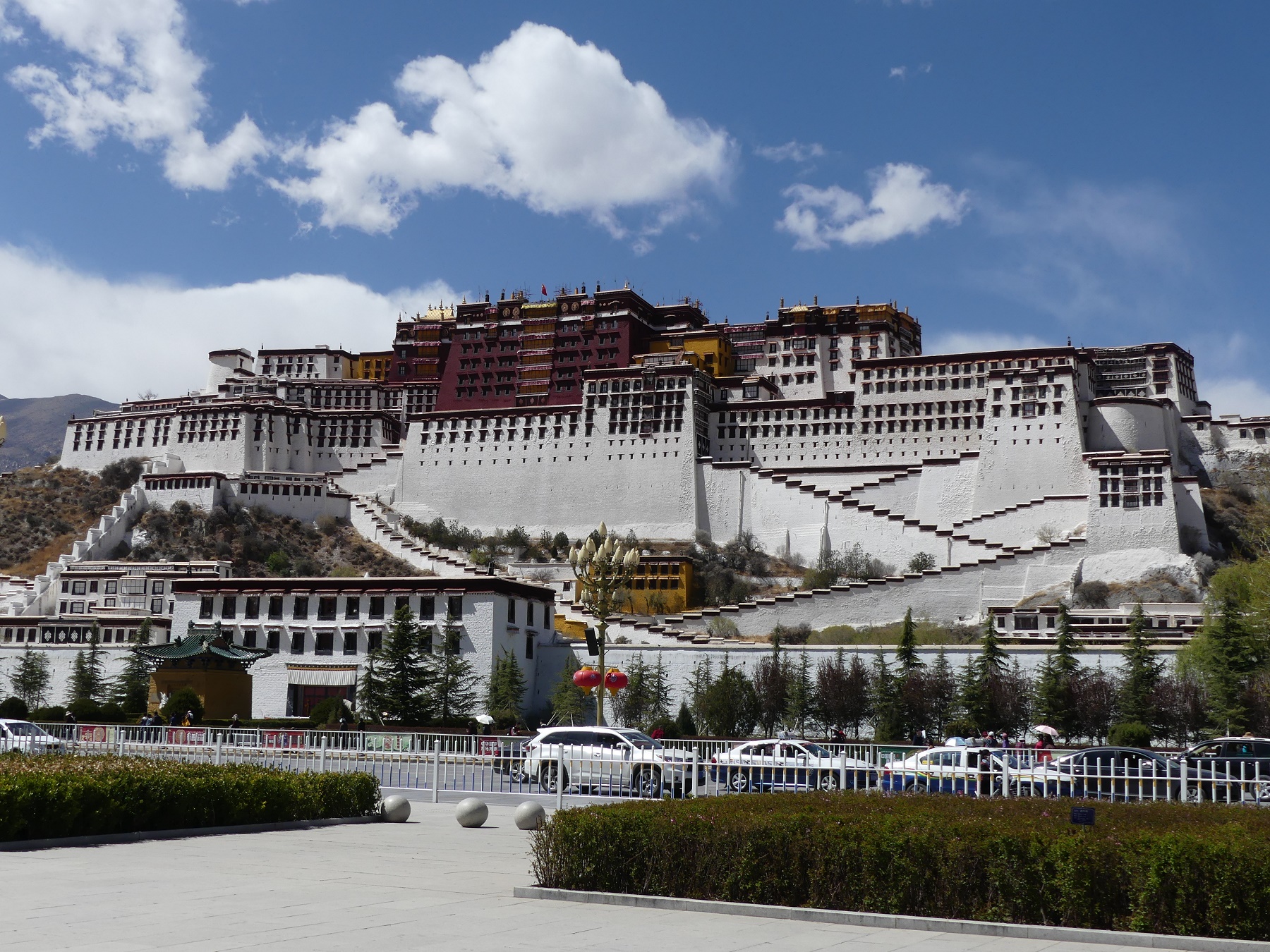
Built in the 7th century, it has presided over Lhasa during all the years of trouble relatively unscathed. We didn’t go inside, as it is part of our itinerary in a few days, but I found myself just staring at the building with a smile on my face. I never thought I would stand in front of it, so I was drinking in the view.
We came back for more of the Potala Palace that first evening and because it was a clear sky, the palace looked even more magical. Because you are only supposed to walk clockwise around any temple of stupa, this meant we of course had to do another circuit of the Barkhor Street. At 10pm at night there was still a steady stream of worshippers and pilgrims praying and prostrating in front of the Jokhang. These are quite a remarkable people.
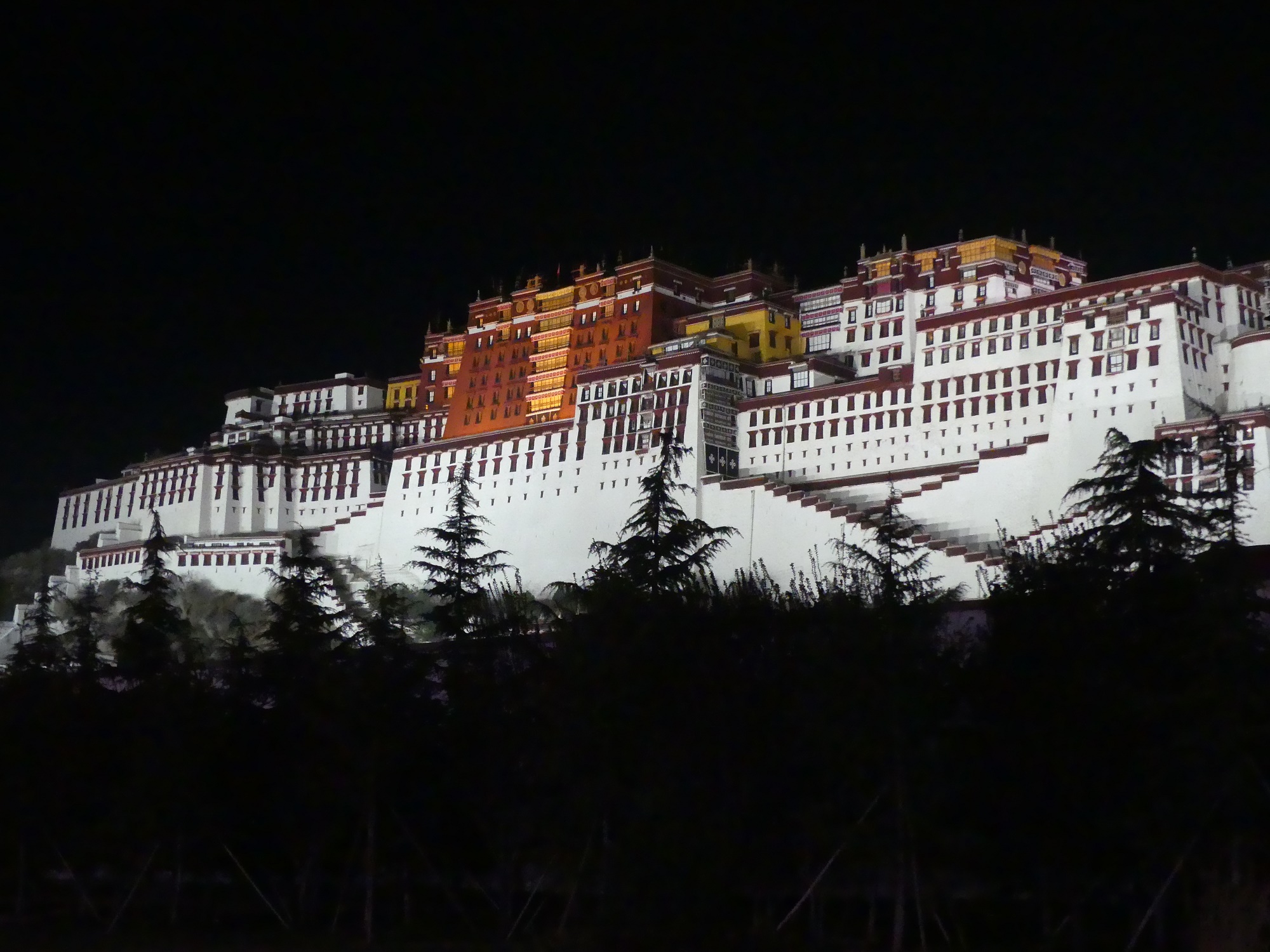
To enter Tibet these days you have to apply for a visitor’s permit. In order to get the permit, you have to take a tour with an approved government travel agency. Even with the permit, you have to get additional permission to leave Lhasa. It is clearly not only the locals the authorities want to keep tabs on!
So this morning we met up with our travel companions. Sarah from England, Maria from Spain (although living in London) and Michaela from Vienna. We piled into our van and headed to the Drepung Monastery. This monastery used to have over 8000 monks in the “pre-liberation” days but now only accommodates about 500. Many of the monasteries suffered badly during the Cultural Revolution and many statues were destroyed. Nowadays the government strictly controls both the numbers and the rights of all the monks. In years past, monks were simply kicked out and were not allowed to congregate. Even within some monasteries today there are “spy monks” (Chinese government officials dressed as tourists or even monks) who monitor the political situation and conversations inside. It seems that the monk’s role in society has been turned into something ceremonial – more of a tourist attraction.
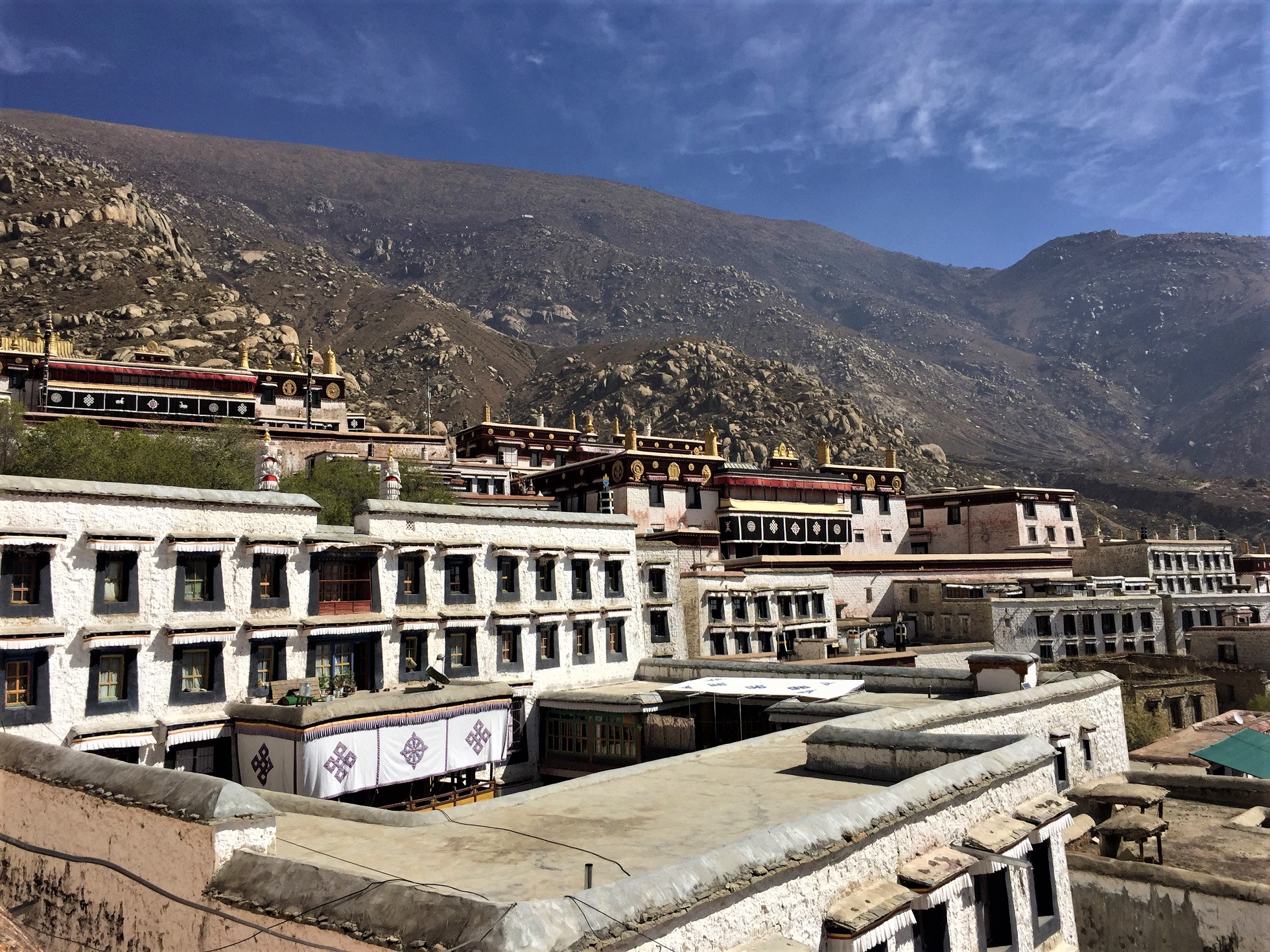
Drepung Monastry
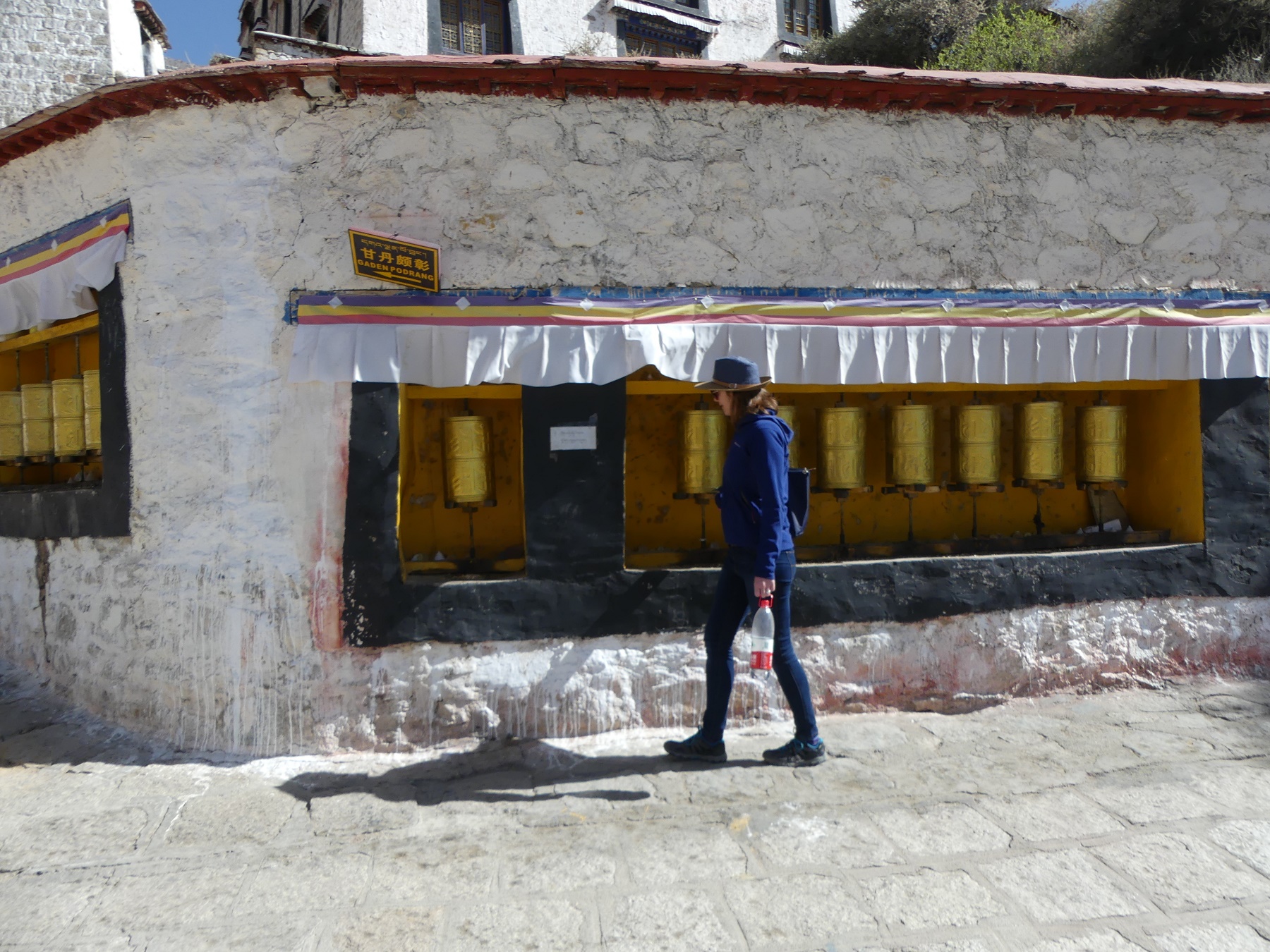
We spent an extensive time in Drepung – too much time if I am honest. There are only so many statues of Buddha I can look at before I get a little bored. The most striking thing though was the amount of donations the monastery collects. Almost every statue, and there were hundreds, is covered in small denominated bills. In-between there were a few more valuable ones. Many of the monks I saw were simply sitting around counting money. It felt a bit sad, especially when you consider who were giving these donations – normally the old or poor. But the Buddhist belief is that you must give in this life to receive better in the next. So I suppose it is like a lifetime savings account that your future self can access.
The other big donation was butter. During the times before electricity, the chapels were all lit by butter lamps. These are huge troughs of waxy butter with about a dozen candles in them that burn constantly. The smell, mixed with the burning incense, can really cause a croaky throat. Many devotees came with flasks of molten butter to pour into the butter troughs to keep the candles burning.
We had only visited one monastery and I already had my fill of past Buddha and future Buddha and stories of fortune tellers that could predict earthquakes caused by upset deities. So I was not looking forward to our post-lunch stop of the Sera Monastery. But I was delightfully mistaken! This time we did not visit chapel after chapel, but got to see the monks debating in the courtyard. It is an interesting educational technique where a teacher will ask the pupil a question and they have to have a theological debate in order to improve their understanding of the issue. What makes it more spectacular to watch (because we clearly could not understand a word spoken in Tibetan) were the hand gestures and actions. As if to emphasise a point, the monk would stamp his foot and clap his hands. Multiply this by the 100 or so monks and you have a very lively edition of Question Time!
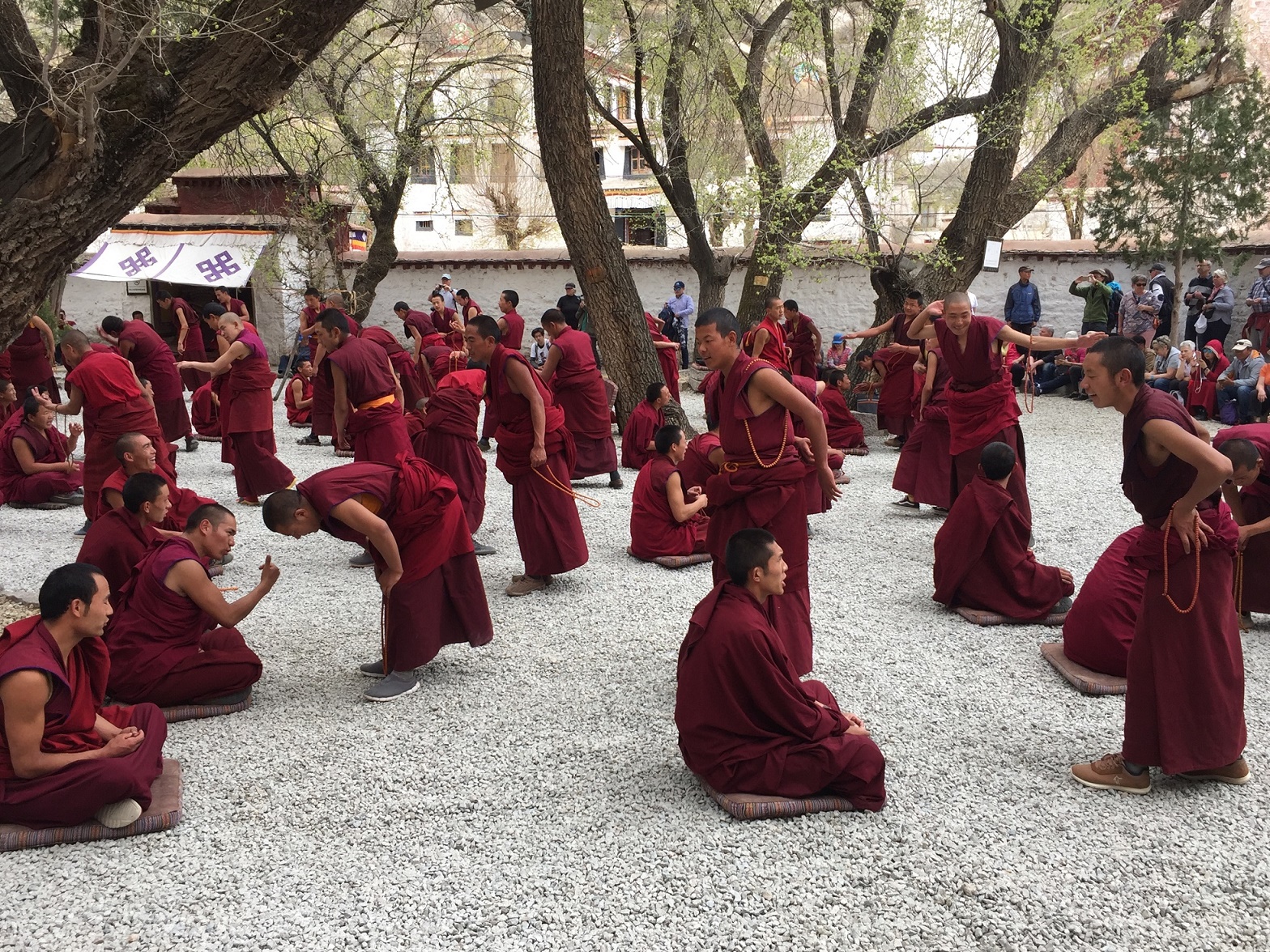
Monks debating at Sera Monastry
Dinner this evening was something different. Our guide recommended going to a restaurant called ‘Tibetan Family Kitchen’ which is quite simply, a Tibetan family kitchen. The family had converted their dining room into a small restaurant. Messages from all over the world were written on the walls saying how wonderful the food and hospitality were so we were looking forward to it. Because we arrived early, we were the only people in the dining room. That all changed when two 8-year olds walked in; they had just finished school and came to do their homework at the dinner table. This was a family home after all. So while we ate the most delicious home-cooked food, family life carried on around us. We decided to down our beers and hurry out the door when one of the sisters put the 18-month old baby on the table and he started running around, almost kicking over the glasses. We put him on the floor and made a dash for the door. What a delightful experience.
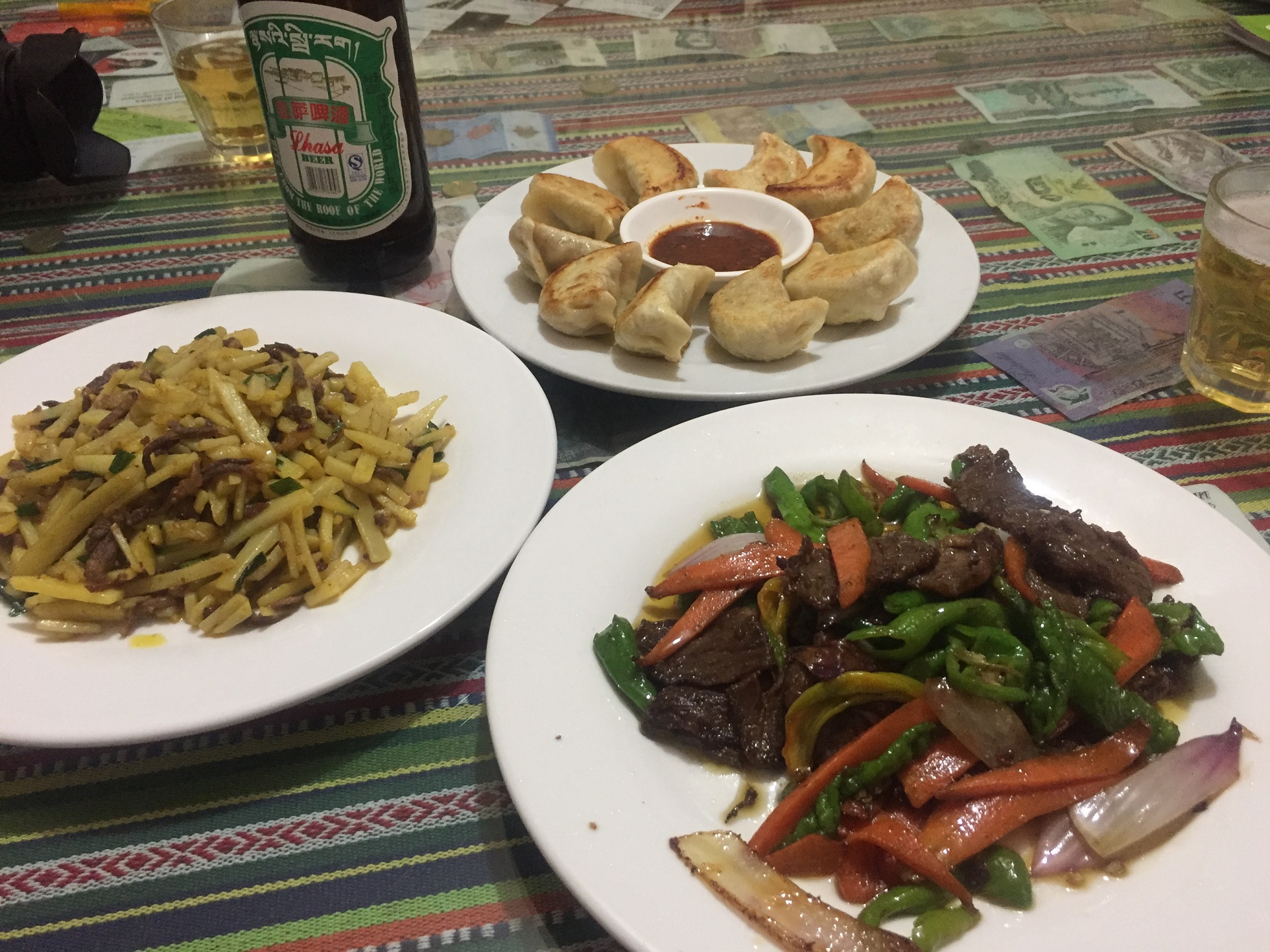
Fried yak momos with fried yak meat and potatoes – delicious!
Today we were visiting the Potala Palace. The Palace is the residence of the Dalai Lama, but since his exile in 1959 the inside has been turned into a museum and tourist attraction. What struck me while waiting in line was the modern irony that the overwhelming majority of tourists were Chinese. All these Chinese tourists were queuing to see the treasures inside a palace that the generation before them tried to destroy during the Cultural Revolution. The Potala is a hugely symbolic landmark in Tibet, but now just sits as a constant reminder that the Chief Resident is in exile.
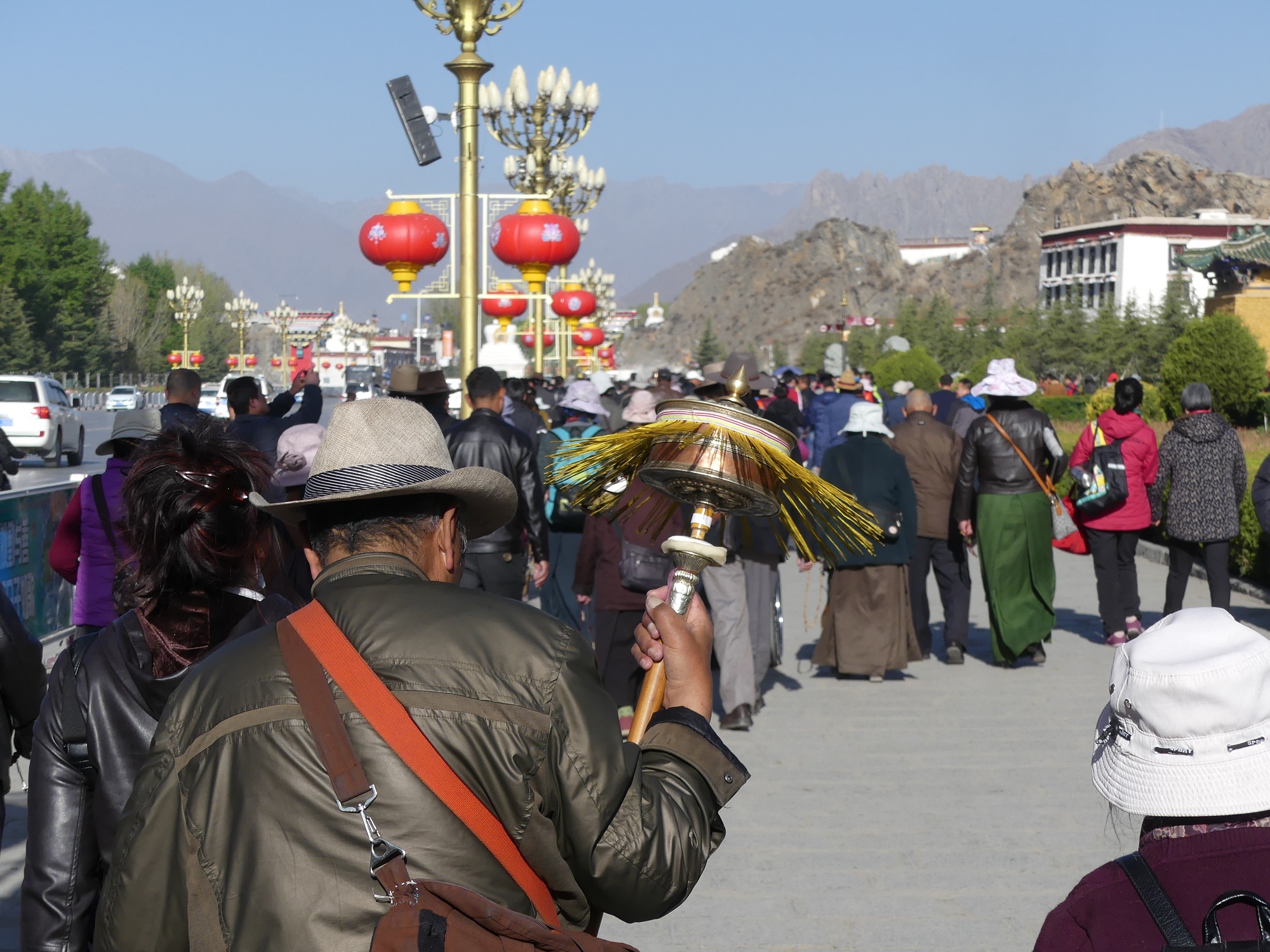
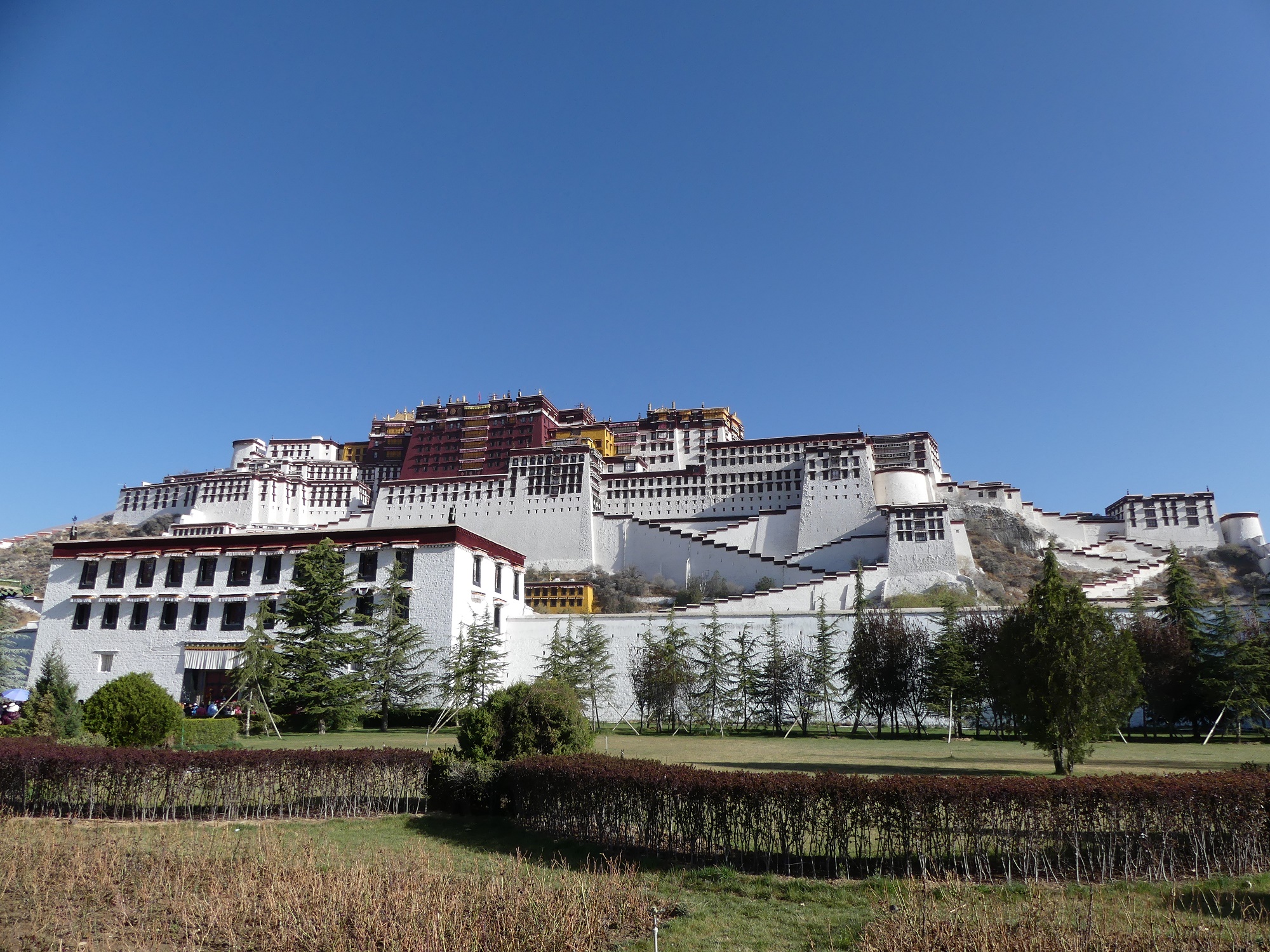
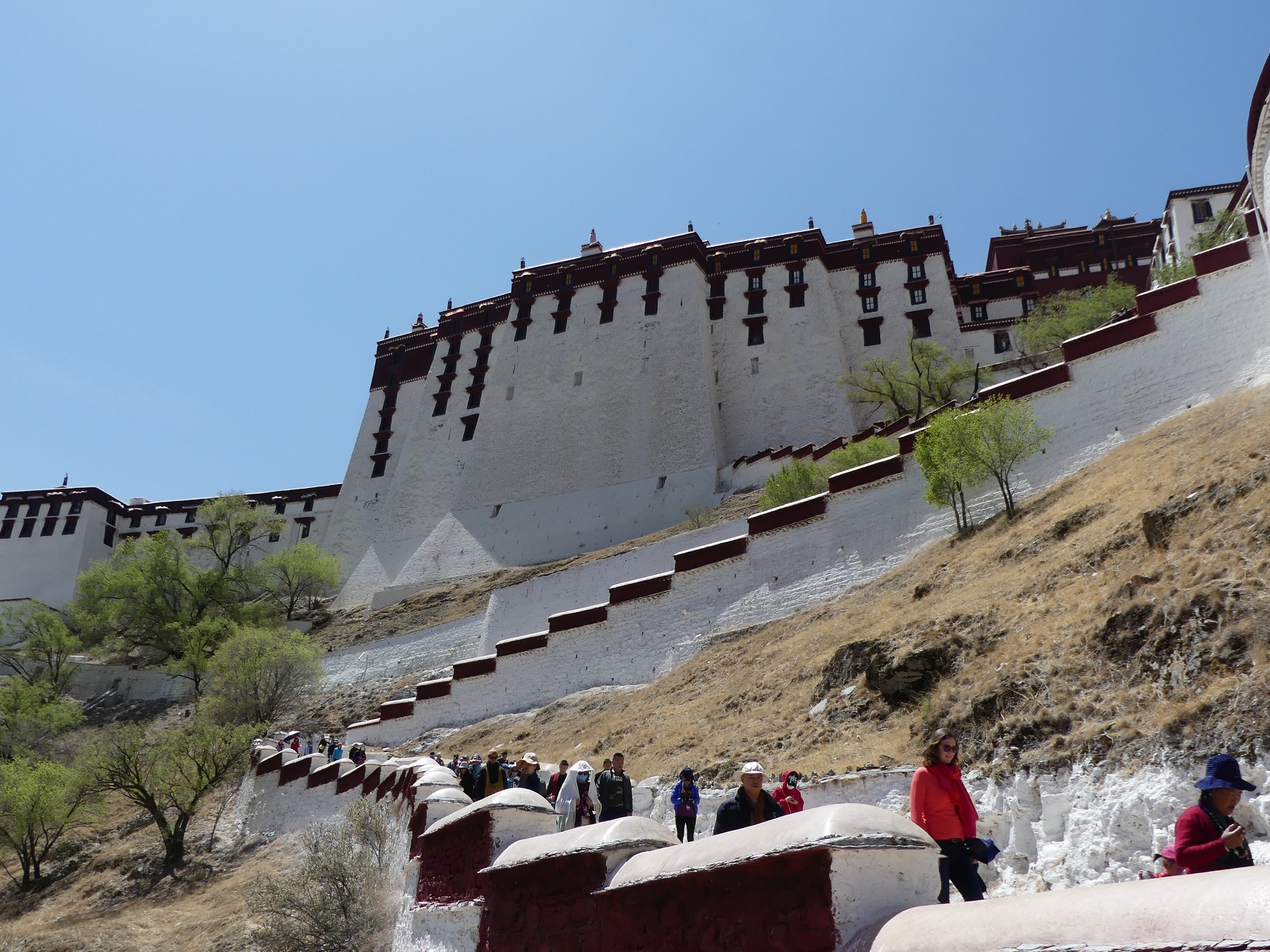
I was still just awestruck to walk around such a beautiful place. Fortunately this time we did not linger at each room and discuss each statue. The palace has over 1000 rooms so it would have taken quite some time. Despite the crowds, it felt like such a privilege to be here.

A view over Lhasa from the Potala Palace
The other major landmark in Lhasa is the Jokhang Temple. We had walked around it so many times the past few days while following people on their spiritual loop, so we were excited to finally go inside. Jokhang Temple is the spiritual centre of Tibet and the holiest destination for all Tibetan Buddhist pilgrims. There is a gold statue of the Buddha from the 7th century, which serves as the holiest shrine. Even here, at this holy and incredibly spiritual place, was a cold police presence that was extremely incongruent to the surroundings. Security cameras at every turn make sure the monks do not get any wild ideas.
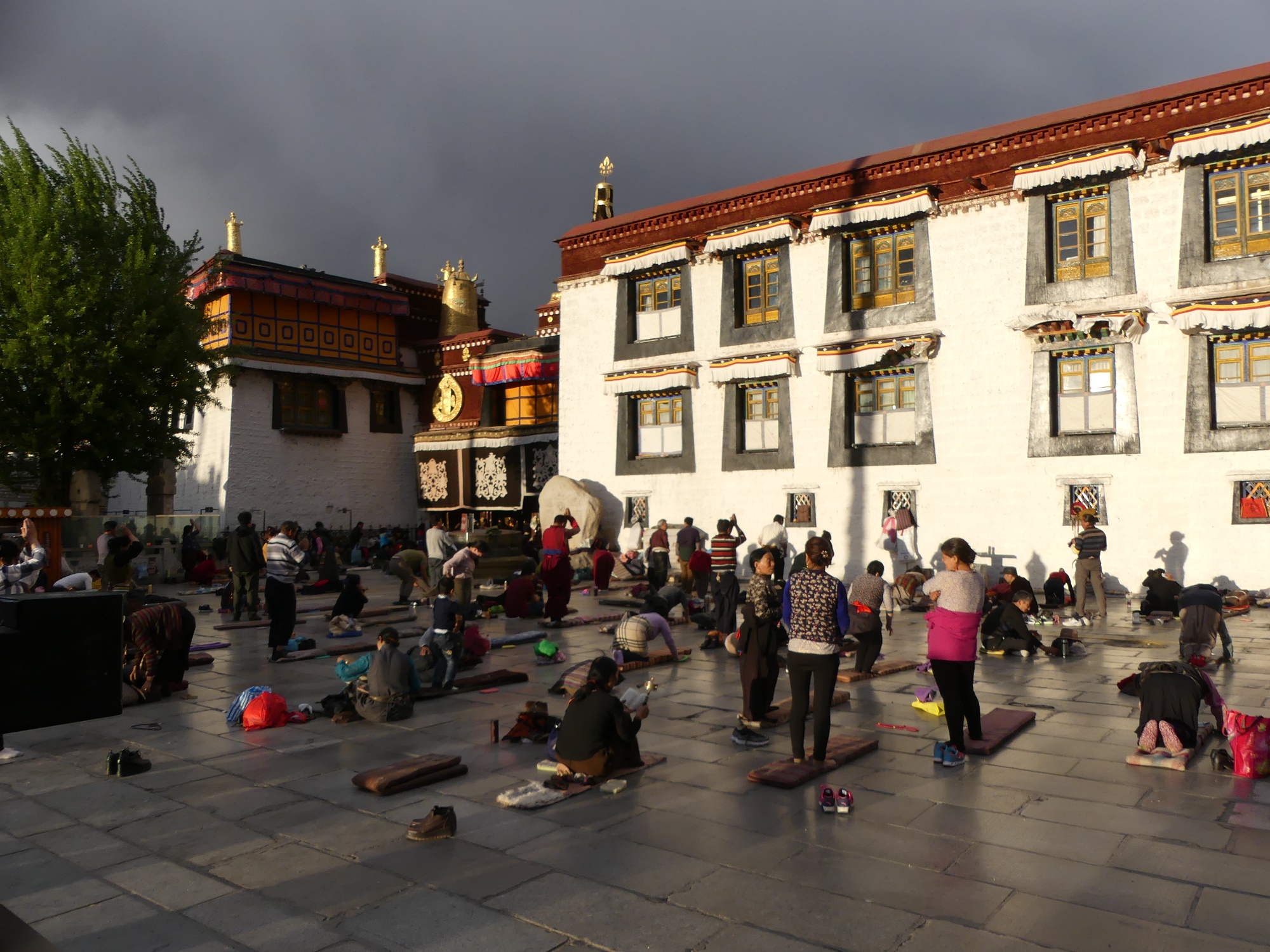
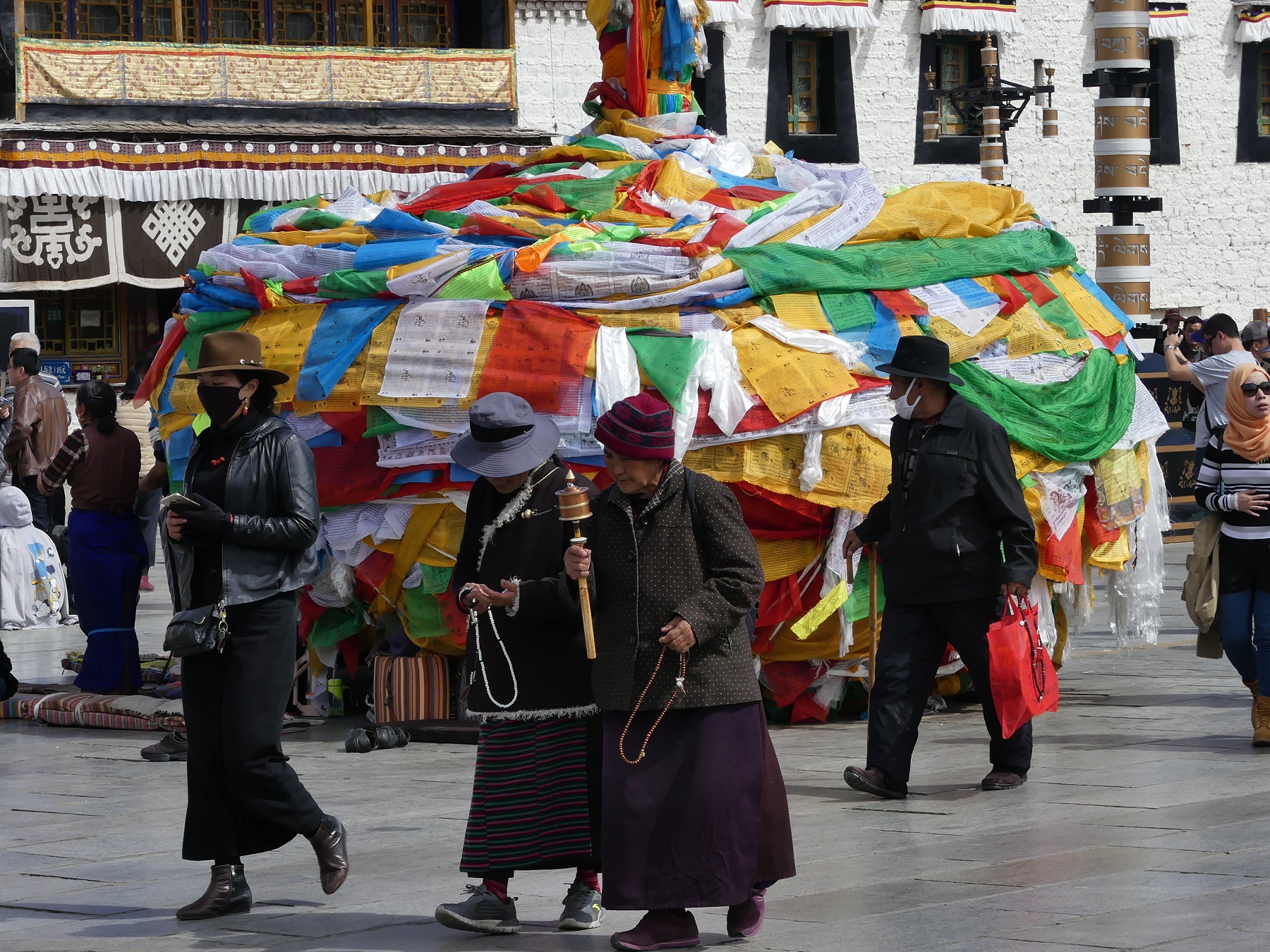
We climbed up to the roof and was blown away by the view. It was incredible. We must have spent over an hour on the roof watching the people file past on their kora circuit. The Potala Palace sat perched on its hill in the distance. Barkhor Square in front was humming with activity. And for the whole time we were there, there were parishioners constantly standing and prostrating themselves before the temple. It was mesmerising to watch.

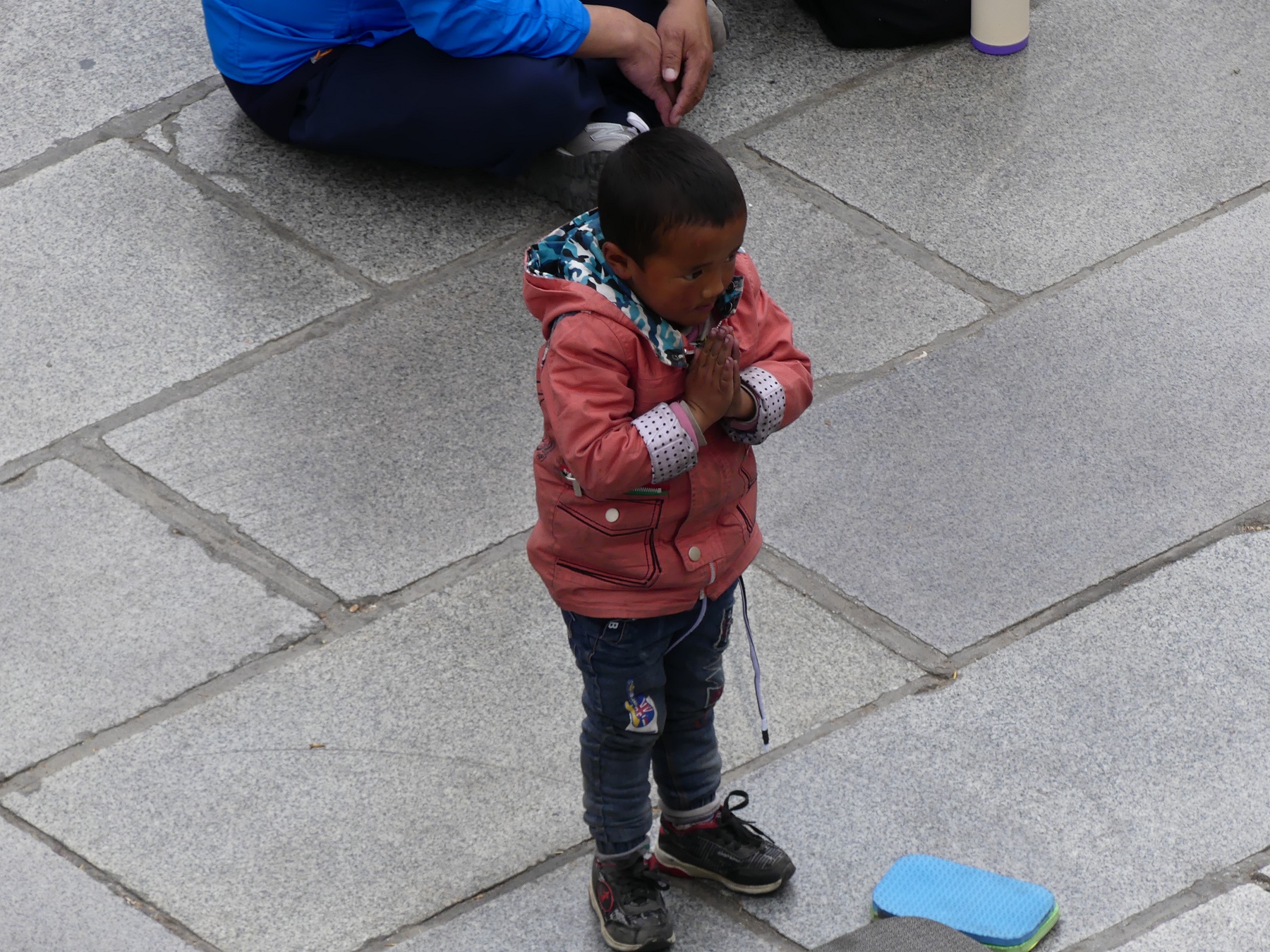
A toddler praying and prostrating in front of the Jokhang Temple
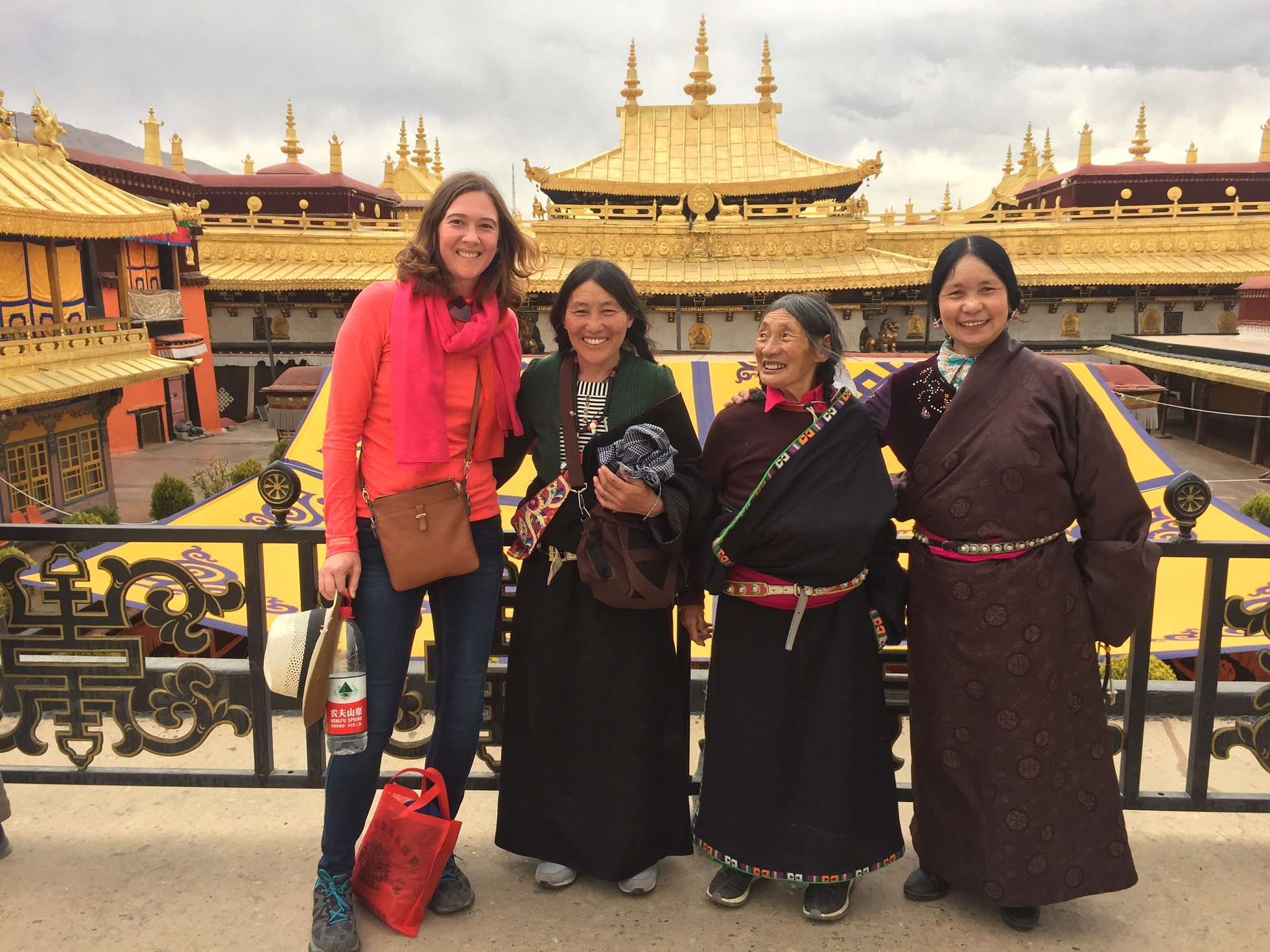
Adrie posing with a few Tibetan women on the roof of Jokhang Temple
We stayed around for a chanting ceremony at Jokhang. At 5pm dozens of monks appeared almost from nowhere. Finally numbering about 60 or so they started a deep low hum of chants from the scriptures in front of them. This was not interrupted when a string of devotees all lined up to shuffle past and give individual donations to each monk. Again, what struck me was the devotion shown by the believers especially the older people. This was contrasted by the boredom and the “going through the motions” body language of some of the monks, but I am not a Buddhist so maybe I am reading it all wrong. But that contrast was quite sad.
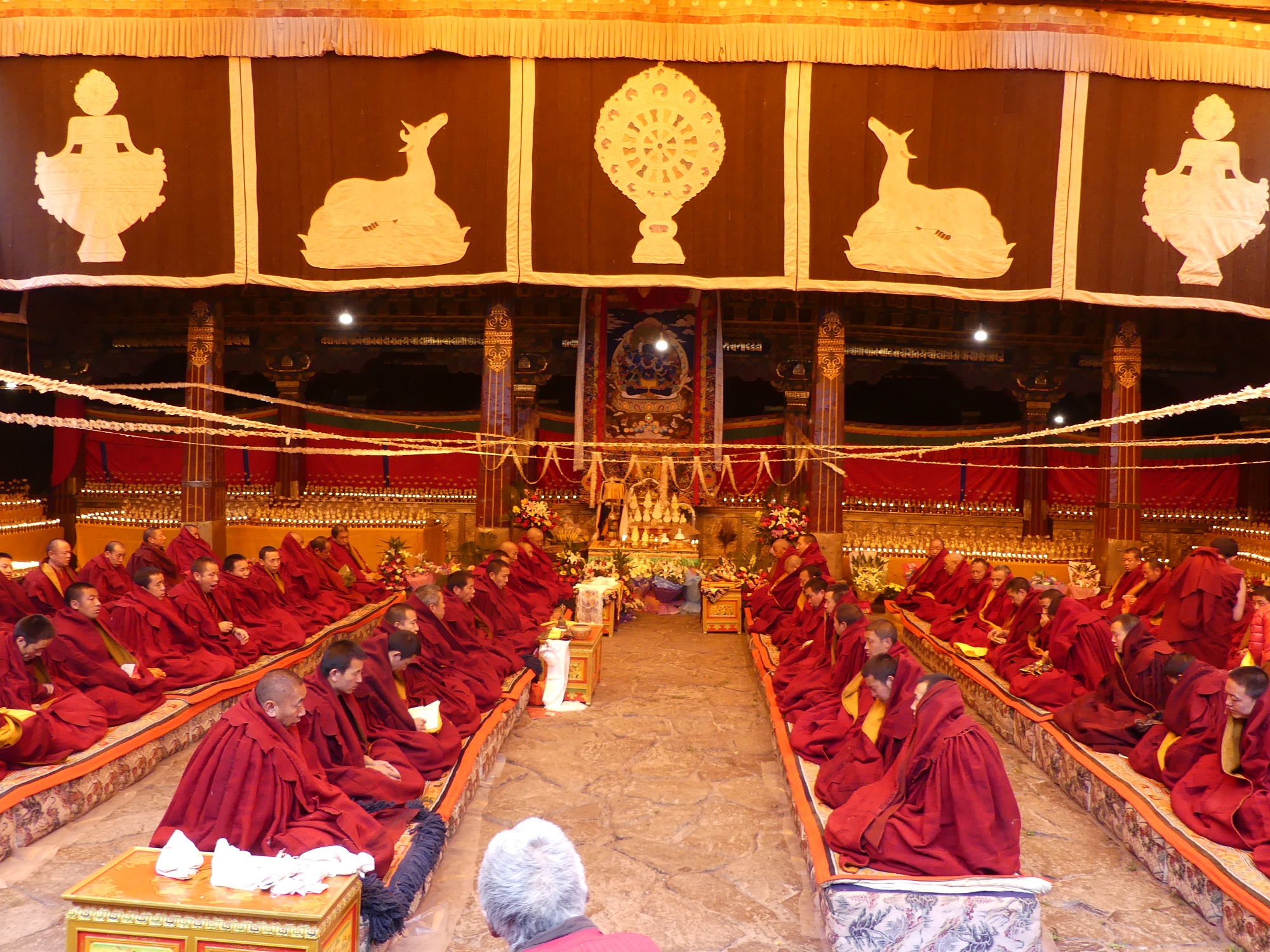
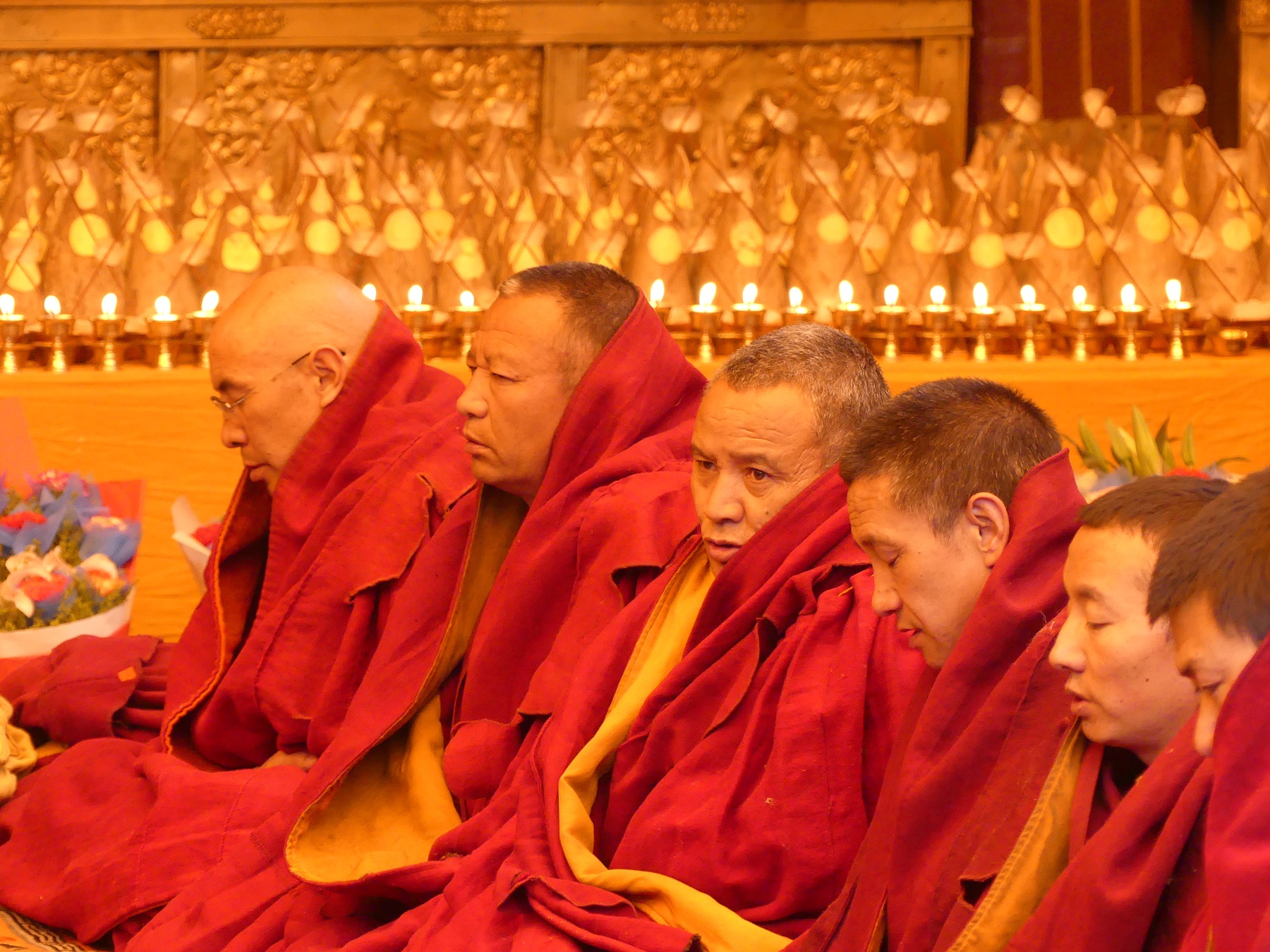
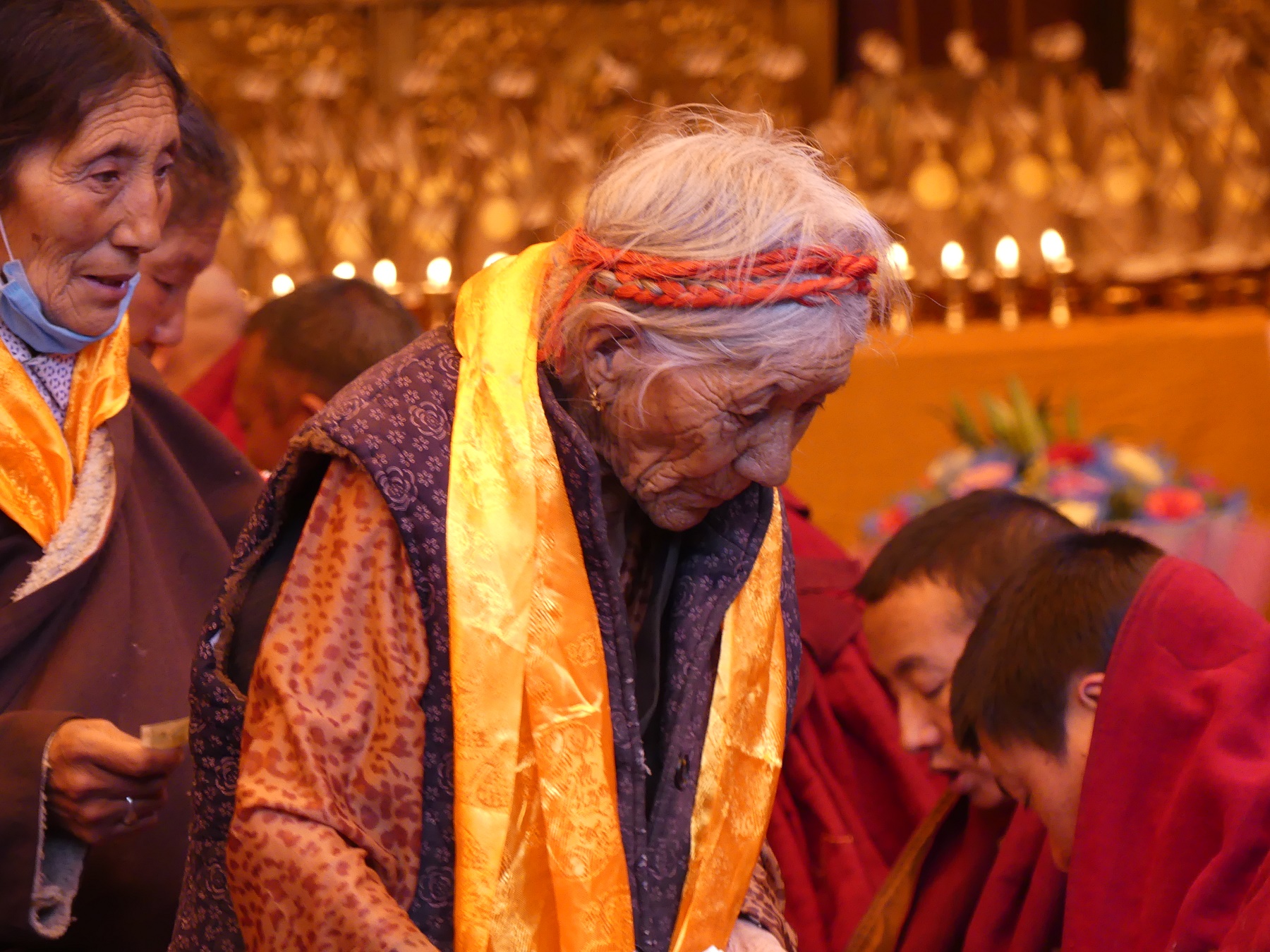
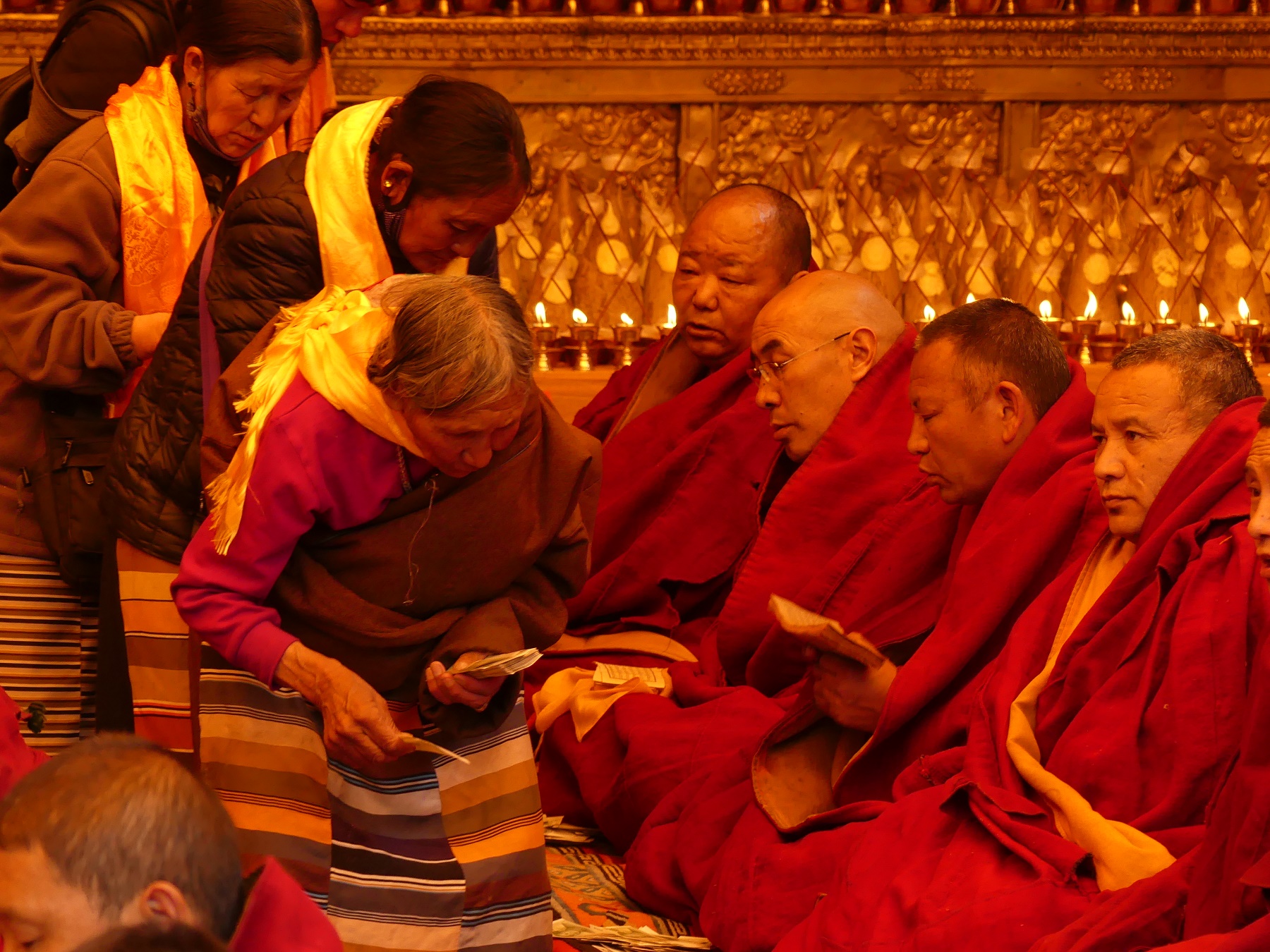
On our final night in Lhasa a few days later we returned to Potala Palace one last time. Unfortunately we got roped into having a final dinner with the group, so we could not stay long but we both enjoyed looking at the Palace all lit up. We enjoyed a walk back through the streets of Lhasa and around Jokhang Temple along the Barkhor circuit. This is the memory I will treasure of this wonderful place.
